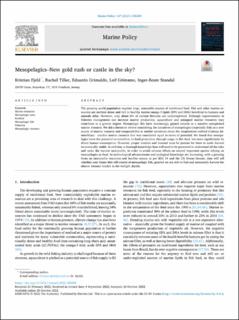| dc.contributor.author | Fjeld, Kristian | |
| dc.contributor.author | Tiller, Rachel | |
| dc.contributor.author | Grimaldo, Eduardo | |
| dc.contributor.author | Grimsmo, Leif | |
| dc.contributor.author | Standal, Inger Beate | |
| dc.date.accessioned | 2023-10-24T09:05:02Z | |
| dc.date.available | 2023-10-24T09:05:02Z | |
| dc.date.created | 2023-03-06T14:23:41Z | |
| dc.date.issued | 2023 | |
| dc.identifier.citation | Marine Policy. 2023, 147, 105359. | en_US |
| dc.identifier.issn | 0308-597X | |
| dc.identifier.uri | https://hdl.handle.net/11250/3098287 | |
| dc.description.abstract | The growing world population requires large, renewable sources of nutritional food. Fish and other marine resources are nutrient dense and rich in healthy marine omega-3 lipids (EPA and DHA) beneficial to humans and animals alike. However, only about 6% of current fisheries are underexploited. Although improvements in fisheries management can increase marine production, aquaculture and untapped marine resources may contribute to a greater degree. Mesopelagic fish have increasingly gained interest as a massive unexploited marine resource. We did a literature review considering the narratives of mesopelagics (especially fish) as a new source of marine resource and compared this to similar narratives about the zooplankton redfeed (Calanus finmarchicus) - another marine resource that was considered equal in terms of potential. We found that mesopelagics have the potential to contribute to food production through usage in fish feed, but more significantly by direct human consumption. However, proper markets and demand must be present for them to make harvest economically viable. In addition, a thorough knowledge base will need to be generated to understand all the risks and make the harvest sustainable, in order to avoid adverse effects on several important species relying on mesopelagics as food. As technological advancements and ecological knowledge are increasing, with a growing focus on sustainable resources and healthy oceans as per SDG 14 and the UN Ocean Decade, time will tell whether your future diet will consist of mesopelagic fish, granted we are able to find and sustainably harvest the elusive treasure hidden in the twilight depths. | en_US |
| dc.language.iso | eng | en_US |
| dc.publisher | Elsevier | en_US |
| dc.rights | Navngivelse 4.0 Internasjonal | * |
| dc.rights.uri | http://creativecommons.org/licenses/by/4.0/deed.no | * |
| dc.title | Mesopelagics–New gold rush or castle in the sky? | en_US |
| dc.title.alternative | Mesopelagics–New gold rush or castle in the sky? | en_US |
| dc.type | Peer reviewed | en_US |
| dc.type | Journal article | en_US |
| dc.description.version | publishedVersion | en_US |
| dc.rights.holder | © 2022 The Author(s). Published by Elsevier. | en_US |
| dc.source.volume | 147 | en_US |
| dc.source.journal | Marine Policy | en_US |
| dc.identifier.doi | 10.1016/j.marpol.2022.105359 | |
| dc.identifier.cristin | 2131628 | |
| dc.relation.project | Norges forskningsråd: 320536 | en_US |
| dc.relation.project | EC/H2020/817806 | en_US |
| dc.source.articlenumber | 105359 | en_US |
| cristin.ispublished | true | |
| cristin.fulltext | original | |
| cristin.qualitycode | 1 | |

